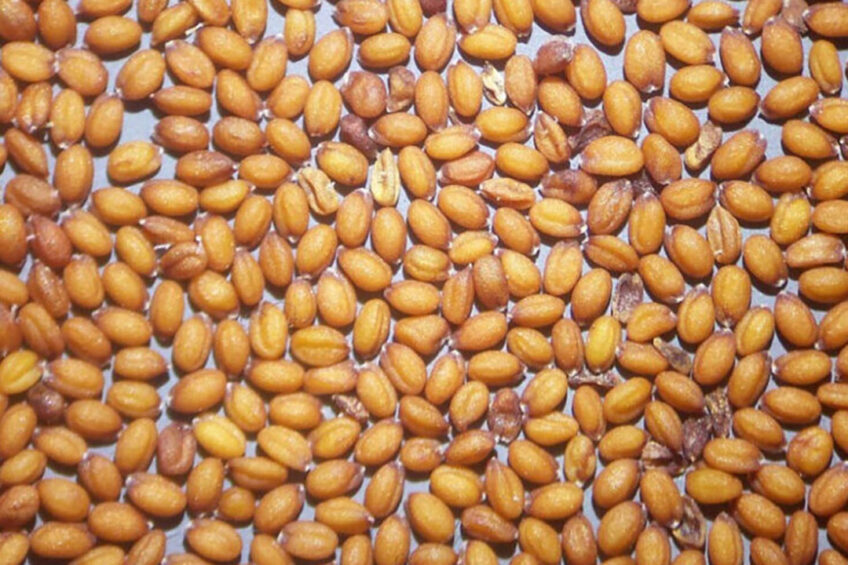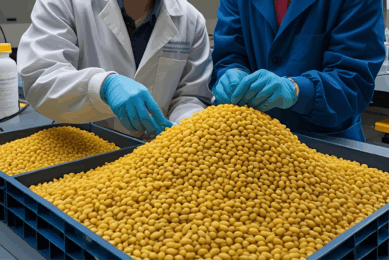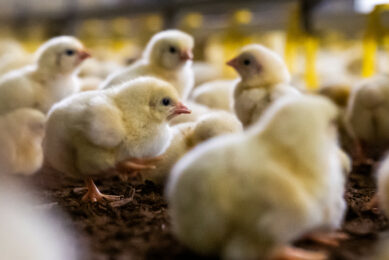Camelina can partly replace soybean meal in broiler diets

Camelina seed oil can be used as a substitute for soybean meal in broiler diets, research conducted by a group of scientists from the Lithuanian University of Health Sciences showed.
Health benefits
“One of the main problems in modern poultry farming is a need for sustainable and inexpensive sources of feed protein alternative to [soybean] meal,” the scientists said, adding that soybean meal production requires huge resources and is not entirely environmentally friendly. “Camelina, on the contrary, is cheap to grow and contains a whole range of useful elements.”
The scientists added: “Now in human nutrition, we see a deficiency of omega-3 polyunsaturated fatty acids, which contributes to depression, cancer, or coronary heart disease. Adding seeds, oil or camelina meal to the bird’s diet will solve this problem.”
An improvement in poultry meat
During several trials, the Lithuanian scientists discovered that adding camelina to the poultry diets improved the quality of poultry meat and liver. Camelina is an oilseed crop containing 36.8% oil in seeds, while in the cake the oil content accounts for 6.4 – 22.7%.
Unique fatty acid composition
If compared with other Brassicaceae family plants, camelina is distinguished by a unique fatty acid composition, because the content of αlinolenic fatty acid varies from 25.9 to 36.7% of total fatty acids. The total tocopherol content in camelina oil and cake are, respectively, 751–900 and 687 mg/kg.
Camelina in poultry diets
The addition of camelina to poultry nutrition increases the amount of n-3 polyunsaturated fatty acids (PUFA) in poultry meat and liver, the scientists said. The content of ALA in chicken muscles increases by 1.3–4.4, 2.4–2.9 and 2.3–7.2 times after supplementing chicken diets with, respectively:
camelina cake (8–24%),
seed (10%), and
oil (2.5–6.9%)
In comparison with the control group:
Camelina cake (5–25%),
seed (10%) and
oil (2.5–4%)
Inclusion in chicken diets result in 1.5–3.9 times higher total n-3 PUFA content in muscles and liver.
Meanwhile, supplementation of chicken diets with camelina oil (4–6.9%), seed (5–10%) and cake (5–25%) results in, respectively, a 1.8–8.4, 1.6–1.9 and 1.3–2.9 times lower n-6/n-3 PUFA ratio in muscles, and 3.29 times lower n-6/n-3 PUFA ratio in the liver, the scientists discovered. After the inclusion of different amounts of camelina cake in chicken diets, a healthy for human nutrition n-6/n-3 PUFA ratio from 1.6 to 2.9 was found in chicken muscles.
Limited use due to antinutrients
The inclusion of 5% camelina seed in the diet had no effect on the growth performance of chickens but feeding 10% seed resulted in lower body weight and body weight gain. The amount of dietary camelina oil ranging from 2.5 to 4.07–6.91% also did not have any effect on the body weight, body weight gain, feed intake or feed conversion ratio of chickens. This could be explained by a lower amount of antinutrients in oil in comparison with cake or seed, the scientists said.
Lower production costs
Poultry with a higher n-3 PUFA content is beneficial to consumers in their pursuit of healthier products, as such meat increases the consumption of currently deficient n3 PUFAs and consequently lowers the risks of cardiovascular diseases.
Moreover, the use of camelina cake in poultry diets lowers the cost price of poultry and enhances the sustainability of poultry growing and biofuel production. Wider use of camelina should reduce, at least partly, the dependence on imported non-sustainable soya bean meal, and induce its cultivation worldwide, thus, increasing the crop variety used in agriculture, the Lithuanian scientists concluded.











